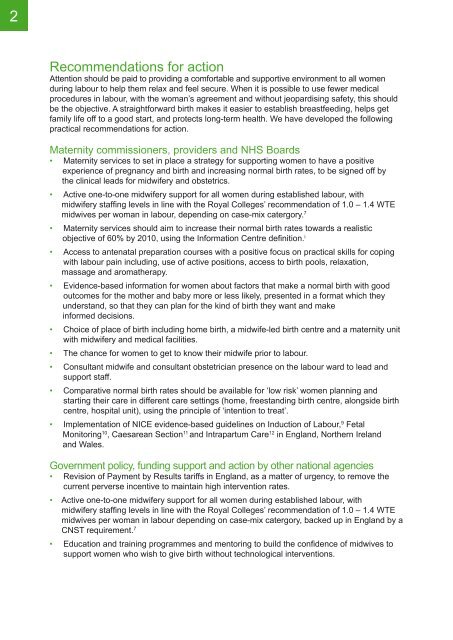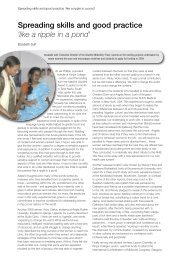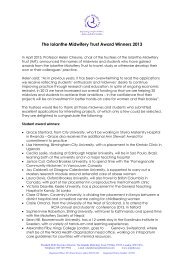Normal Birth Consensus Statement - Royal College of Midwives
Normal Birth Consensus Statement - Royal College of Midwives
Normal Birth Consensus Statement - Royal College of Midwives
You also want an ePaper? Increase the reach of your titles
YUMPU automatically turns print PDFs into web optimized ePapers that Google loves.
2<br />
Recommendations for action<br />
Attention should be paid to providing a comfortable and supportive environment to all women<br />
during labour to help them relax and feel secure. When it is possible to use fewer medical<br />
procedures in labour, with the woman’s agreement and without jeopardising safety, this should<br />
be the objective. A straightforward birth makes it easier to establish breastfeeding, helps get<br />
family life <strong>of</strong>f to a good start, and protects long-term health. We have developed the following<br />
practical recommendations for action.<br />
Maternity commissioners, providers and NHS Boards<br />
• Maternity services to set in place a strategy for supporting women to have a positive<br />
experience <strong>of</strong> pregnancy and birth and increasing normal birth rates, to be signed <strong>of</strong>f by<br />
the clinical leads for midwifery and obstetrics.<br />
• Active one-to-one midwifery support for all women during established labour, with<br />
midwifery staffing levels in line with the <strong>Royal</strong> <strong>College</strong>s’ recommendation <strong>of</strong> 1.0 – 1.4 WTE<br />
midwives per woman in labour, depending on case-mix catergory. 7<br />
• Maternity services should aim to increase their normal birth rates towards a realistic<br />
objective <strong>of</strong> 60% by 2010, using the Information Centre definition. i<br />
• Access to antenatal preparation courses with a positive focus on practical skills for coping<br />
with labour pain including, use <strong>of</strong> active positions, access to birth pools, relaxation,<br />
massage and aromatherapy.<br />
• Evidence-based information for women about factors that make a normal birth with good<br />
outcomes for the mother and baby more or less likely, presented in a format which they<br />
understand, so that they can plan for the kind <strong>of</strong> birth they want and make<br />
informed decisions.<br />
• Choice <strong>of</strong> place <strong>of</strong> birth including home birth, a midwife-led birth centre and a maternity unit<br />
with midwifery and medical facilities.<br />
• The chance for women to get to know their midwife prior to labour.<br />
• Consultant midwife and consultant obstetrician presence on the labour ward to lead and<br />
support staff.<br />
• Comparative normal birth rates should be available for ‘low risk’ women planning and<br />
starting their care in different care settings (home, freestanding birth centre, alongside birth<br />
centre, hospital unit), using the principle <strong>of</strong> ‘intention to treat’.<br />
• Implementation <strong>of</strong> NICE evidence-based guidelines on Induction <strong>of</strong> Labour, 9 Fetal<br />
Monitoring10 , Caesarean Section11 and Intrapartum Care12 in England, Northern Ireland<br />
and Wales.<br />
Government policy, funding support and action by other national agencies<br />
• Revision <strong>of</strong> Payment by Results tariffs in England, as a matter <strong>of</strong> urgency, to remove the<br />
current perverse incentive to maintain high intervention rates.<br />
• Active one-to-one midwifery support for all women during established labour, with<br />
midwifery staffing levels in line with the <strong>Royal</strong> <strong>College</strong>s’ recommendation <strong>of</strong> 1.0 – 1.4 WTE<br />
midwives per woman in labour depending on case-mix catergory, backed up in England by a<br />
CNST requirement. 7<br />
• Education and training programmes and mentoring to build the confidence <strong>of</strong> midwives to<br />
support women who wish to give birth without technological interventions.





